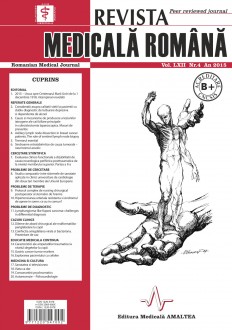SELECT ISSUE

Indexed

| |

|
|
|
| |
|
|
|

|
|
|
|
|
|
|
HIGHLIGHTS
National Awards “Science and Research”
NEW! RMJ has announced the annually National Award for "Science and Research" for the best scientific articles published throughout the year in the official journal.
Read the Recommendations for the Conduct, Reporting, Editing, and Publication of Scholarly work in Medical Journals.
The published medical research literature is a global public good. Medical journal editors have a social responsibility to promote global health by publishing, whenever possible, research that furthers health worldwide.
LYMPHANGIOMA-LIKE KAPOSI SARCOMA: CHALLENGES IN DIFFERENTIAL DIAGNOSIS
S.R. Georgescu, A.M. Limbau, M. Tampa, M.D. Tanasescu, S. Zurac and M.I. Popa
ABSTRACT
Background. Kaposi’s sarcoma (KS) is a multifocal vascular neoplasia with uncertain histogenesis, characterized by angioproliferative multifocal tumors affecting mainly the skin. The “lymphangioma-like” or “bullous KS” variant is a rare morphologic expression of KS, accounting for less than 5% of all cases and appearing among all KS epidemiological subtype. This review provides a comprehensive overview of clinical and pathological characteristics of patients with lymphangioma-like Kaposi’s sarcoma LLKS.
Methods. We included 93 patients with Kaposi sarcoma, aged between 36 and 90 years; diagnosis was made as a result of the histopathological examination. The surgical excision samples were fixed in 10% buffered formalin, paraffin embedded and stained with Hematoxylin-Eosin for histopathological examination. Immunohistochemical staining was performed using the following antibodies: CD34, CD31, actin, myoglobin, desmin, cytokeratin and vimentin.
Results. The histological features of LLKS vary considerably from the traditional KS, classic KS areas have been absent from some lymphangioma-like KS. Most of the patients were diagnosed in nodular stage and confirmed by positive immunohistochemical staining. Clinically, each patient presented with violaceous patches, papules or plaques; some of the patients presented with bullous lesions. All tumour cells, including those associated with LLKS foci, showed a strong and diffuse reactivity for anti-HHV-8 LNA-1and anti-CD34.
Conclusions. Differential diagnosis of lymphangioma-like Kaposi’s sarcoma LLKS with other vascular tumors may be very difficult and a detailed histologic study in combination with immunohistochemistry, such as staining for HHV-8 latent nuclear antigen, is essential for correctly diagnosing lymphangioma-like KS.
Keywords: lymphangioma-like Kaposi’s sarcoma, differential diagnosis, immunohistochemical staining
